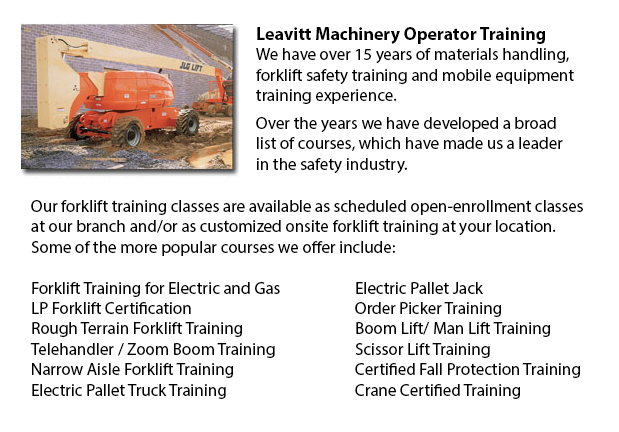
Aerial Platform Training Saskatoon - Aerial forklifts can be utilized to accomplish several distinctive tasks done in hard to reach aerial places. Some of the tasks associated with this style of lift include performing routine maintenance on buildings with lofty ceilings, repairing phone and power cables, lifting heavy shelving units, and pruning tree branches. A ladder could also be used for some of the aforementioned jobs, although aerial platform lifts provide more safety and stability when properly used.
There are several versions of aerial hoists accessible on the market depending on what the task required involves. Painters sometimes use scissor aerial lifts for instance, which are classified as mobile scaffolding, of use in painting trim and reaching the 2nd story and higher on buildings. The scissor aerial platform lifts use criss-cross braces to stretch and lengthen upwards. There is a platform attached to the top of the braces that rises simultaneously as the criss-cross braces elevate.
Cherry pickers and bucket trucks are a further version of the aerial lift. Commonly, they contain a bucket at the end of a long arm and as the arm unfolds, the attached bucket lift rises. Platform lifts utilize a pronged arm that rises upwards as the handle is moved. Boom hoists have a hydraulic arm which extends outward and hoists the platform. All of these aerial lifts require special training to operate.
Training programs offered through Occupational Safety & Health Association, known also as OSHA, cover safety methods, machine operation, repair and inspection and device weight capacities. Successful completion of these education courses earns a special certified license. Only properly licensed individuals who have OSHA operating licenses should operate aerial lift trucks. The Occupational Safety & Health Organization has developed guidelines to uphold safety and prevent injury when using aerial platform lifts. Common sense rules such as not using this apparatus to give rides and making sure all tires on aerial lifts are braced so as to prevent machine tipping are referred to within the rules.
Unfortunately, data expose that in excess of 20 aerial lift operators die each year while operating and nearly ten percent of those are commercial painters. The majority of these mishaps were triggered by improper tie bracing, therefore many of these may well have been prevented. Operators should make certain that all wheels are locked and braces as a critical safety precaution to prevent the machine from toppling over.
Marking the surrounding area with noticeable markers need to be utilized to protect would-be passers-by in order that they do not come near the lift. Also, markings must be set at about 10 feet of clearance amid any power cables and the aerial hoist. Lift operators must at all times be well harnessed to the hoist when up in the air.
-
Scissor Lift Safety Training Saskatoon
Scissor Lift Safety Training Saskatoon - A scissor lift is a type of platform lift that moves vertically. The lift table is moved in a vertical motion because of criss-cross folding supports that are linked in what is called a pantograph. The platfor... More -
Crane License Saskatoon
Crane License Saskatoon - The operator of a crane has to have been certified with a crane operator license or certification. In order to practice as a crane operator, the credentials are considered mandatory. Licensing consists of training and final... More -
Order Picker Training Saskatoon
Order Picker Training Saskatoon - Order picker's allows warehouse staff to lift pallets making use of forks. Likewise known as a stock picker, this particular electrically-powered machinery is like a forklift except that an order picker is also made... More -
Scissor Lift Training Saskatoon
Scissor Lift Training Saskatoon - While operating a scissor lift, they have to be used competently so as to protect the wellbeing of the other employees inside the workplace and to protect the safety of the equipment. Skilled operators are trained to... More -
Telehandler Training Courses Saskatoon
Telehandler Training Courses Saskatoon - Employers are responsible for making certain that their operating personnel and supervisors are trained to work proficiently utilizing telehandler equipment. The skill level of employees need to be assessed. I... More -
Aerial Boom Lift Training Saskatoon
Aerial Boom Lift Training Saskatoon - For individuals who operate or supervise the use of aerial lift platforms, proper aerial boom lift Training is required. The aerial lift platform is for lifting people, tools and materials to elevated work locati... More -
Narrow Aisle Forklift / Order Picker Training / Electric Pallet Jack / Electric Pallet Truck Training in Saskatoon
A pallet jack is an appliance built especially for transporting pallets of differing weights and dimensions. They may be used in conjunction with cranes, forklifts and other heavy duty machinery as an attachment piece or to be used on their own. Pall... More -
Boom Lift Operator Training Saskatoon
Boom Lift Operator Training Saskatoon - A cherry picker refers to a type of aerial work platform. Cherry pickers include a bucket or platform at the hydraulic lifting system's end. The machine is also known as a man lift, boom lift, basket crane or h... More

Forklift Training Saskatoon
TOLL FREE: 1-888-254-6157
Saskatoon, Saskatchewan
forklifttrainingsaskatoon.com
Email Us
About Us



